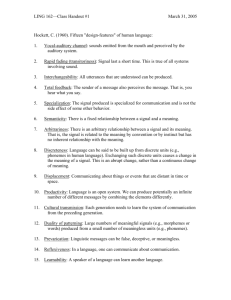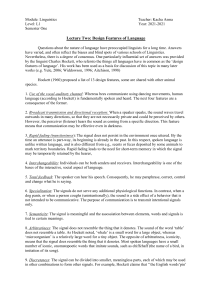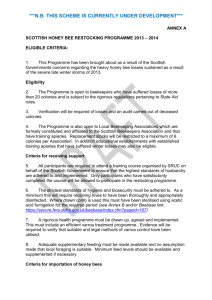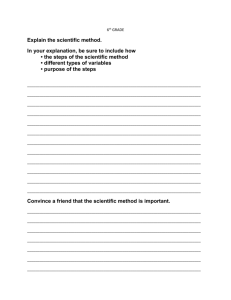The origins of language, human and animal language
advertisement
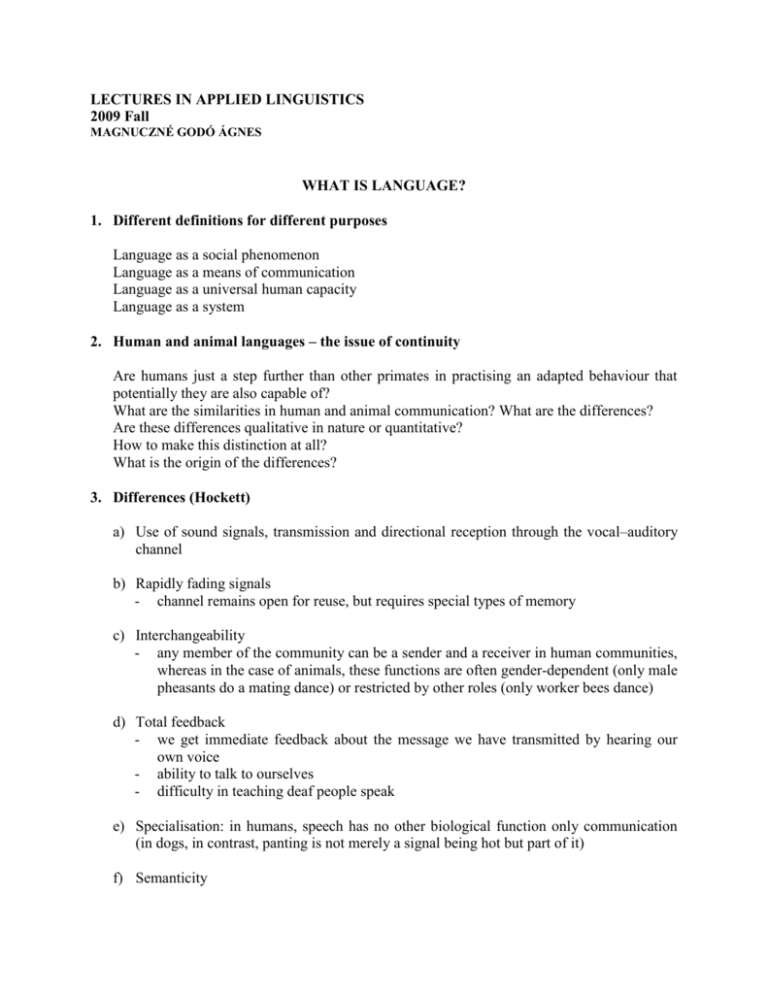
LECTURES IN APPLIED LINGUISTICS 2009 Fall MAGNUCZNÉ GODÓ ÁGNES WHAT IS LANGUAGE? 1. Different definitions for different purposes Language as a social phenomenon Language as a means of communication Language as a universal human capacity Language as a system 2. Human and animal languages – the issue of continuity Are humans just a step further than other primates in practising an adapted behaviour that potentially they are also capable of? What are the similarities in human and animal communication? What are the differences? Are these differences qualitative in nature or quantitative? How to make this distinction at all? What is the origin of the differences? 3. Differences (Hockett) a) Use of sound signals, transmission and directional reception through the vocal–auditory channel b) Rapidly fading signals - channel remains open for reuse, but requires special types of memory c) Interchangeability - any member of the community can be a sender and a receiver in human communities, whereas in the case of animals, these functions are often gender-dependent (only male pheasants do a mating dance) or restricted by other roles (only worker bees dance) d) Total feedback - we get immediate feedback about the message we have transmitted by hearing our own voice - ability to talk to ourselves - difficulty in teaching deaf people speak e) Specialisation: in humans, speech has no other biological function only communication (in dogs, in contrast, panting is not merely a signal being hot but part of it) f) Semanticity - ability to attach abstract varied meaning to language forms (bees: only about nectar) g) Openness, creativity - animals work with a limited set of messages and forms tied to circumstances and triggered by specific stimuli (sharks, lizards, turkeys) - human language is constantly changing, new items and message types can be added; human creatively use it h) Arbitrariness - often a strong connection between the signal and the message (e.g. To warn off an opponent, the animal may simulate attacking behaviour) - human language is largely arbitrary, no connection between signal and meaning, interpretation is based on consensus i) Discreteness - the constituents of human language can be clearly distinguished from one another on each level of organisation, not characteristic of animal sign systems j) Duality - animals work with a basic stock of sound signals each corresponding to a type of message, sound signals are used in isolation, not combined - human language demonstrates a characteristic double structure on one level consisting of sound units or phonemes meaningless in themselves, on the other level combined to produce varied messages (some birdsongs are similar) k) Patterning - animal languages are a simple list of elements without any internal organisation - human language is built up on different levels of organisation according to welldefined patterns - sounds: a,b,s,t : bats, stabs but NOT sbat - words: boathouse vs. houseboat Jack kissed Mary. Vs. Mary kissed Jack. But NOT Kissed Jack Mary. l) Structure dependence m) Functionality, intention (dolphins, Skinners doves, Clever Hans, Washoe and Sarah) n) Displacement - ability to communicate about things and event far away in place and time (bees vs. humans) o) Reflexiveness - using language to talk about language (‘metalanguage’) p) Prevarification - to use language to mislead others deliberately q) Traditional transmission - of birds and bees 4. What is language? a) Systematic and generative b) A set of arbitrary symbols c) Primarily verbal signals, but also visual d) Conventionalised meaning e) Used for communication only f) Operates in a speech community g) Essentially human h) Both language and language learning have universal features Seminar in Applied Linguistics Lesson 3. 2009 Fall Magnuczné dr. Godó Ágnes What is language? Human and animal communication? Reading: Cook, G. (2003). Applied linguistics. Ch. 2. Prescribing and describing. Pp. 12-20. Wardhaugh, R. (1994). Investigating language. Ch. 2. Do only humans talk? Pp. 56- 61. Presentations: On birds and bees Talking apes 1. Pit Corder claims that the reason why it is difficult to define language is that we need different definitions for different purposes. For what different ‘purposes’ can you imagine different definitions? How would they differ? 2. Do you think there are more and less primitive cultures and languages? In what sense can we speak about primitive language and culture? 3. What is correctness? 3.1 Why is the sentence ‘He didn’t do nothing.’ Incorrect? 3.2 How can you make a scientific claim about a piece of language being ‘correct’? 3.3 What justifies the existence of non-standard forms according to Cook? (pp.15-16). Are his arguments acceptable? 4. Can you see the ambiguity in the following sentences? What enables you to identify the twofold meaning? 4.1 He kissed the girl in the bus. 4.2 They took her flowers. 4.3 She commented on the page. 4.4 He took down the name. 5. Compare human and animal communication systems on the basis of Hockett’s criteria and offer specific examples. 6. Terminology Arbitrariness, conventionalised meaning, speech community, genetically inbuilt, cultural transmission, duality, displacement, patterning, metalanguage, structural dependence, qualitative and quantitative difference, reflexiveness, prevarification
